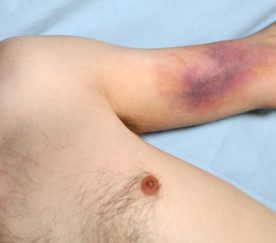How to Get Rid of a Bruise
Every time a part of your body meets a hard object, the impact smashes tiny blood vessels under your skin. Blood leaks out, pooling under your skin and leaving a black-and-blue mark.

Eventually your body absorbs the blood and the bruise fades. As you age, your skin becomes thinner and your capillaries more fragile, and it takes less impact to create a bruise. Certain medications can intensify bruising, including blood thinners, birth control pills, diuretics, and aspirin.
Treat the Bruise Immediately
Right after bumping into something you know will leave a bruise, follow these steps.
- Apply a cold compress for 30 minutes.
- Then apply a hot compress for three to five minutes.
- Repeat Steps 1 and 2 at least twice over the next 24 hours for a mild injury, or every three or four waking hours over the next 48 hours for a more severe injury.
- Apply arnica cream or ointment and repeat every one to two hours.
Why It Works
The cold compress reduces swelling and discoloration by shrinking blood vessels and sealing off leaking blood vessels. Conversely, the warm compress brings more blood and healing nutrients to the area, helping your body repair leaky blood vessels and reabsorb the blood quicker.
We love arnica for its ability to reduce pain and inflammation. It’s the most common ingredient in homeopathic preparations for bruises.
Other Medicines
Herbs and Supplements
Bromelain. Studies find this enzyme, derived from pineapple stems, reduces swelling and bruising. It not only interferes with the inflammatory actions of chemicals called leukotrienes, but also disrupts the action of enzymes involved in inflammation. Take 500 milligrams two or three times a day. For a very large bruise, double the dose during the first 24 hours.
Other Approaches
Traumeel ointment or gel. This homeopathic product contains arnica, calendula, belladonna, and many other herbs known to reduce pain and swelling and speed healing. In one study, injured rats treated with the product had less swelling and healed more quickly than rats not treated with it. Rub a small amount into the bruise and reapply several times a day.
Prevention
Eat more brightly coloured fruits and vegetables. They contain high amounts of flavonoids, antioxidant plant pigments that protect cell structures, enhance the action of vitamin C (see below), and reduce inflammation. Many high-flavonoid foods are also rich in vitamin K, which aids in blood clotting.
Take vitamin C with bioflavonoids. Vitamin C builds collagen around blood vessels and in the skin, preventing bruising. Take 1,000 milligrams twice a day for three weeks, then decrease to 500 milligrams twice a day.



